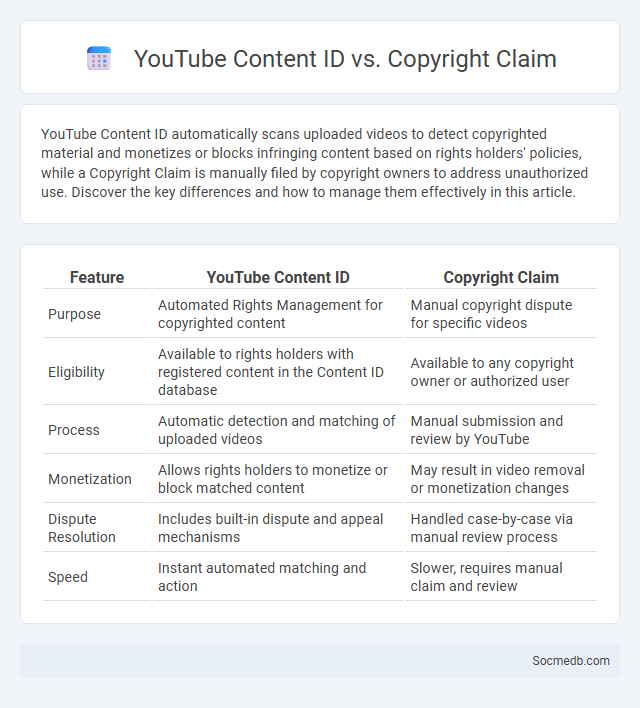
Photo illustration: YouTube Content ID vs Copyright Claim
YouTube Content ID automatically scans uploaded videos to detect copyrighted material and monetizes or blocks infringing content based on rights holders' policies, while a Copyright Claim is manually filed by copyright owners to address unauthorized use. Discover the key differences and how to manage them effectively in this article.
Table of Comparison
| Feature | YouTube Content ID | Copyright Claim |
|---|---|---|
| Purpose | Automated Rights Management for copyrighted content | Manual copyright dispute for specific videos |
| Eligibility | Available to rights holders with registered content in the Content ID database | Available to any copyright owner or authorized user |
| Process | Automatic detection and matching of uploaded videos | Manual submission and review by YouTube |
| Monetization | Allows rights holders to monetize or block matched content | May result in video removal or monetization changes |
| Dispute Resolution | Includes built-in dispute and appeal mechanisms | Handled case-by-case via manual review process |
| Speed | Instant automated matching and action | Slower, requires manual claim and review |
Understanding YouTube Content ID
YouTube Content ID is a powerful tool that helps copyright owners manage their content on the platform by automatically identifying and managing copyrighted material. Your videos are scanned against a vast database of registered audio and video files to detect matches, enabling rights holders to monetize, block, or track usage. Understanding how Content ID works is essential for creators to protect their work while complying with YouTube's copyright policies and avoiding potential strikes.
What Is a Copyright Claim on YouTube?
A copyright claim on YouTube occurs when a content owner identifies their protected material in a video and asserts their rights through YouTube's Content ID system. This claim can result in the video being monetized by the copyright owner, blocked in certain regions, or muted, depending on the rights holder's preferences. Understanding the difference between a copyright claim and a copyright strike helps creators manage their content and avoid potential penalties.
How Content ID Works on YouTube
Content ID on YouTube automatically scans uploaded videos against a database of copyrighted material, identifying matches through digital fingerprints and metadata analysis. When a match is found, copyright owners can choose to block the video, monetize it by running ads, or track viewer statistics, ensuring their rights are protected. You can manage your content's presence by reviewing disputes and claims through YouTube's Content ID system to maintain control and avoid potential infringement issues.
Key Differences: Content ID vs Copyright Claim
Content ID is an automated system used by platforms like YouTube to identify and manage copyrighted material in uploaded videos, allowing rights holders to monetize, track, or block content worldwide. A Copyright Claim, however, is a manual process where a rights owner directly asserts infringement on specific content, which may lead to video removal or restrictions. Understanding these distinctions helps you better protect your intellectual property and navigate content policies effectively.
Who Can Use YouTube Content ID?
YouTube Content ID is available to eligible copyright owners such as media companies, music labels, and content creators with original material. These users must meet YouTube's requirements, including owning exclusive rights to the content and applying through the YouTube Content ID registration process. Your ability to use Content ID depends on verifying ownership and ensuring that your copyrighted videos maintain compliance with YouTube's policies.
Typical Scenarios Leading to Copyright Claims
Social media platforms often face copyright claims due to users sharing copyrighted content without permission, such as music, videos, and images. Viral reposts of copyrighted materials or unauthorized use of trademarked logos in posts frequently trigger infringement notices. User-generated content, including memes or edits that incorporate protected works, also commonly leads to disputes over copyright ownership.
How to Respond to a Content ID Claim
To respond effectively to a Content ID claim on social media platforms like YouTube, review the specific claim details and verify whether the content truly infringes copyright. If you believe the claim is incorrect, submit a dispute by providing clear evidence of ownership or fair use justification, ensuring compliance with copyright policies. Prompt and accurate responses help maintain your channel's standing and avoid potential strikes or restrictions.
Impact of Copyright Claims on Monetization
Copyright claims on social media significantly affect content creators' ability to monetize their videos, leading to demonetization or revenue sharing with copyright holders. Platforms like YouTube use automated Content ID systems to detect copyrighted material, which often results in blocked ads or removal of monetization privileges. This process can limit creators' earnings and discourage original content production, altering the digital economy for influencers and brands.
Disputing Content ID and Copyright Claims
You can challenge false Content ID and copyright claims by submitting a dispute directly to the platform hosting your social media content. Providing clear evidence of your ownership or fair use rights strengthens your case and speeds up resolution. Understanding the specific appeal process on sites like YouTube or Facebook helps protect your content and maintain your online presence effectively.
Best Practices to Avoid Content ID Issues
To avoid Content ID issues on social media, ensure all uploaded content is original or properly licensed with verified rights. Utilize platforms' copyright management tools to monitor and address potential infringements promptly. Consistent metadata tagging and transparent attribution further reduce the risk of Content ID claims and maintain compliant digital presence.
 socmedb.com
socmedb.com